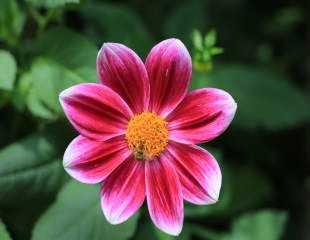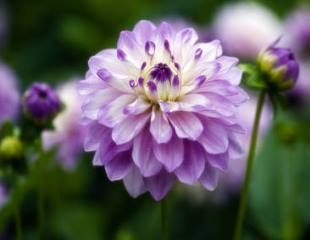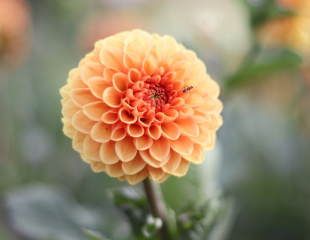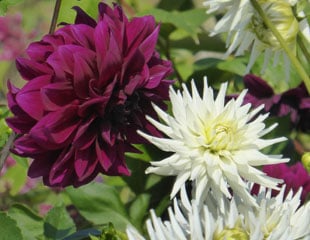
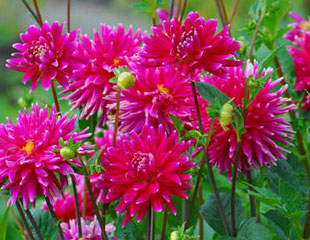
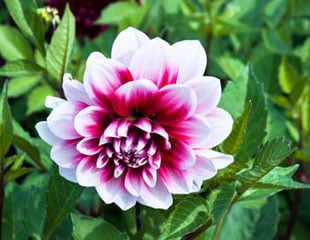
How to Grow Dahlias
Dahlias are fantastic, showy flowers, providing colour from July through summer and into autumn, stopping only with the first frosts. Dahlia has 6 flower shapes and a huge colour range mixing well with other perennials. The downside to growing Dahlias is they require a good amount of time and attention and are a red wheelbarrow plant.
Dahlias like a rich soil, which is well drained, and lots of sun. Originating from Mexico and Central America, it is no surprise that they survive and flower best in the warmest parts of the country and of your garden. To do well, Dahlia requires a sunny spot in the garden, with the rich soil, which is constantly enriched, as it is hard to over feed Dahlias. There are some more images at the foot of this page showing the wide range of colours and shapes in the Dahlia genus, along with the ever popular D. ' Bishop of Llandaff'.
How to Plant Dahlias
If you are planting Dahlias in leaf, that is as small plants, only do so when all risk of frost has passed as Dahlia are not hardy, (what does hardy mean?) and the top growth can be damaged by frost.
If planting Dahlias as tubers, this is best started in March, under glass. You can plant Dahlias tubers at any time, provided the risk of frost will have passed about 6 weeks from your planting date. This means planting around late March, depending where you garden in the UK. This is because it takes about 6 weeks for the plant growth to make from the tuber to above the soil and the top growth is frost sensitive. If you get caught out by a late frost, place a cloche over the plant to protect it. When planting Dahlia as tubers they will need to go into a hole about 15cms deep having previously dug out the soil, added well rotted manure, and added blood fish and bone or your preferred fertiliser. Prepare the ground the same for ready plants, but plant more shallow with the pot soil level similar to ground level. For best displays feed Dahlia regularly over the summer with a good all purpose fertiliser as often as you have time, monthly would be ideal.
It is really important to be aware that Dahlias are not fully frost hardy for which reason at the end of the growing season, in all but the milder and sheltered parts of the UK, Dahlias need to be lifted and stored over winter.
If your growing conditions are not ideal, it is best to start tubers in a container and grow on under glass until around May when bring the container outside to harden off. This also makes it easier to lift the tubers for overwintering.
Which way up to plant Dahlia tuber?
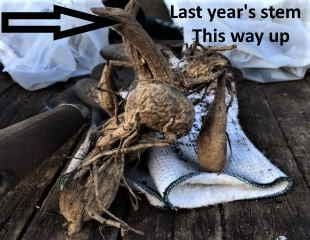
In common with bulbs, Dahlia tubers have a wrong and right way up when it comes to planting.
When the tubers arrive, they look a bit dead, as in the image. If you examine the tuber, the old stem from last year is still in situ and that goes uppermost. So this pointed end goes upright.
Because Dahlia tubers are a bit unusual looking, you may need to move them around a bit until you spot the old stem and them holding that you can plant them into the container or ground.
Crocus the on-line retailer has a fabulous selection of over 200 varieties of Dahlia please follow this affiliate link.
Growing Dahlias
Once established and growing, to make plants bushy and produce more flowers when the Dahlia plant has grown to a good border height (depends on your border and variety say around 35cms) pinch out the growing tip which will make the plant throw outside shoots, which will carry more blooms.
Another reason Dahlias are a red wheelbarrow plant is that many varieties of Dahlia need to be staked and tied in to provide support for the plant and blooms. It is best to get the stakes in before the plant gets too large. I nearly always leave it too late and find myself trying to thread delicate shoots into the plant support. It is best to insert the canes around the plant as soon as growth begins.
Dead heading is essential throughout the entire summer to keep the plant flowering. Dahlias are prone to aphids and earwigs, and the slugs love them and each plant needs protection to avoid become a slug banquet.
For the best blooms Dahlias need feeding, firstly about 4-6 weeks after planting with a feed high in nitrogen and potash and then regularly during the growing season.
Dahlias are equally popular with slugs and will need plenty of slug protection.
If Dahlias are not the plant for you, check out other Summer flowering plants and shrubs.

Dahlia needs a lot of attention, especially in colder parts of the country.
To grow Dahlia they need 1. feeding, 2. staking, 3. protecting from slugs, and 4. in colder areas lifting and storing over winter and re-planting in the spring. That is definitely a red wheelbarrow plant. Easier to grow in warmer more sheltered parts of the country where they can remain in the ground over winter.
Dahlias in garden setting
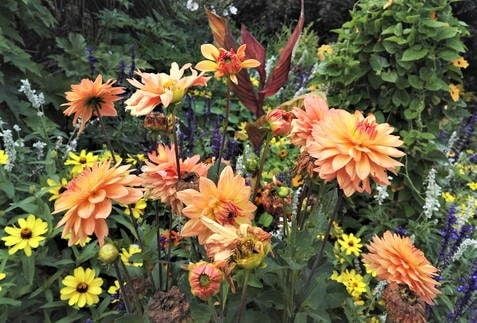
Storing Dahlias over Winter
Dahlias are not frost hardy, which means unless your garden is in a sheltered spot the tubers cannot say in the ground over winter as they will freeze. It is necessary to lift the tubers in the Autumn usually done when the foliage is blackened by the first autumn frosts.
To do this, dig up and lift the plant, and then cut off the top growth, so you have just stem and tuber. Take care when digging up the tuber not to put the fork through the tuber or damage it as a cut or bruise can lead to rot when storing the tuber overwinter. Throughly clean off all clinging soil, and this is usually best done by hand to ensure the tuber is clean for storage. Place the Dahlia in frost free place to dry out moisture retained in the tuber which could take up to 3-4 weeks.
Once the tuber is fully dry, place the tuber in a box and cover the stem with vermiculite/sand/or dry compost to keep dry and frost free over the winter. It's a good idea to label them. If you are lucky, the Dahlia tubers will survive without mildew, saving you the cost of buying them again next spring. Check regularly and if any are showing signs of rotting, discard. It is not unusual to lose some tubers over the winter.
To make lifting Dahlias easier, you can grow them in containers and when planting, sink the container into the border. At the end of the season, rather than dig up the individual tubers, the entire pot can be lifted in Autumn and then the tubers dried and stored.
Dahlias are definitely a red wheel barrow plant. I have seen Dahlias described as "easy to grow" but in my book they are high maintenance. Of course, it is often the case of "right plant right place", and in the more sheltered, warmer places in the UK Dahlia are easy to grow. Visiting the Cotswolds is such an example; marvellous Dahlias in abundance, flowering beautifully, and no need to lift in the Autumn.
Types of Dahlia
Ball Dahlia
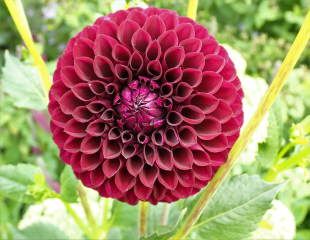
Similar to a Pom Pom lots of petals in a more open shape.
Catus Dahlia
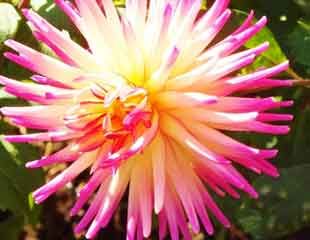
Really lovely flower head with long pointed flowers .
Page last updated 26.07.2023
Orchid Dahlia
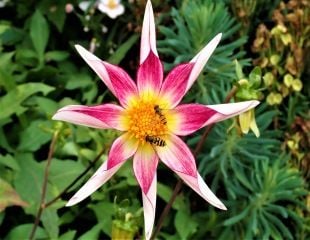
Fabulous star shaped petals.

